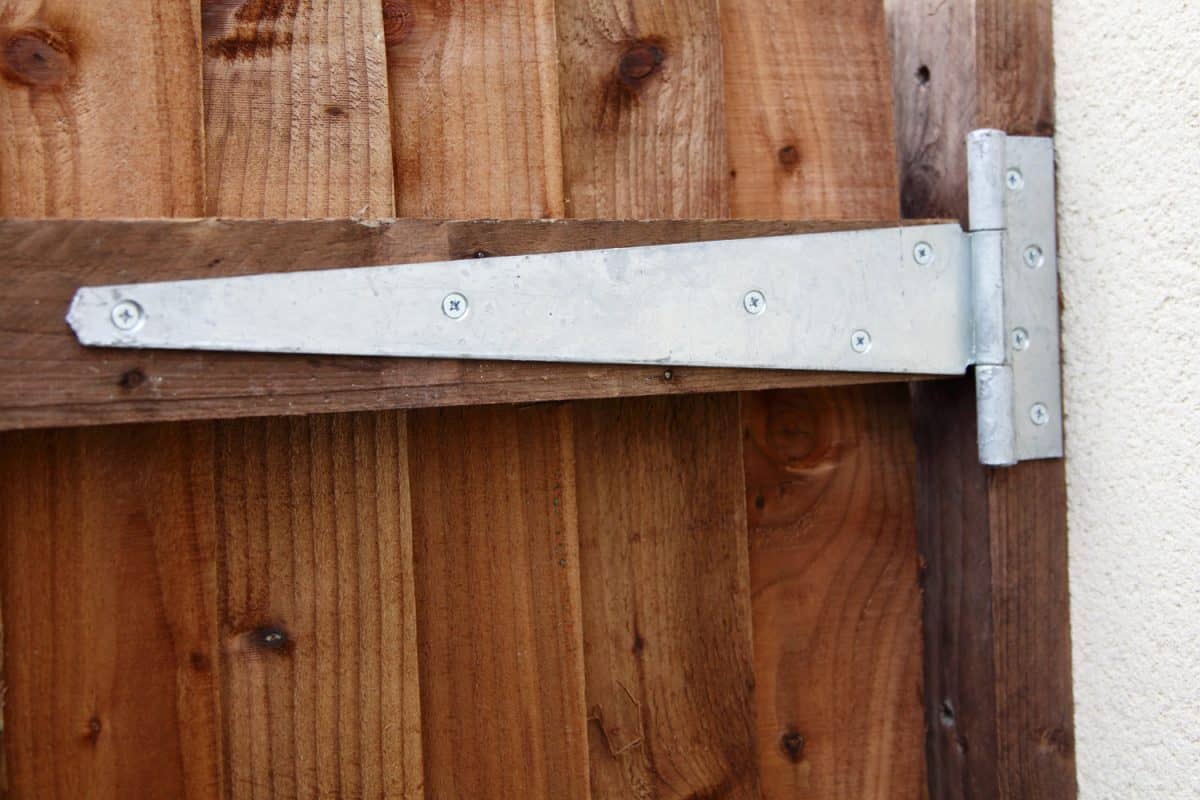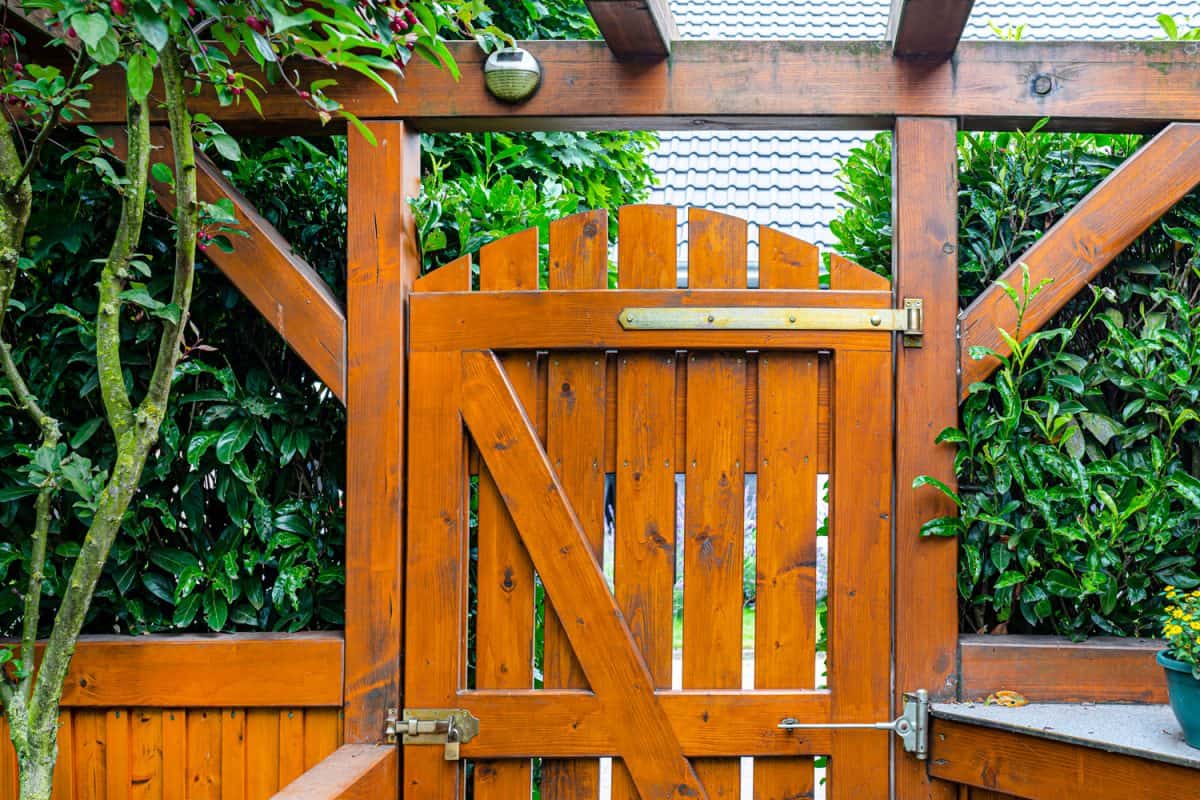Are you about to install a gate for your fence, and you’re wondering how far apart should you place the gate hinges? Wonder no more, for we have researched this question, and we have the answer for you.
There is no standard distance between gate hinges. What you should consider is the weight of the gate that you are installing and the weight capacity of the hinge that you decide to use. The key is in choosing the right hinge for your gate.
Let’s talk more about the different hinges and how they are installed in the succeeding sections. Read on!

How to choose the right gate hinge?
Gates normally use two hinges, one near the top and another at the bottom. The total combined weight capacity of the two hinges should be able to support the weight of the gate.
If you’re going to install a heavier gate, you can install three or even four hinges to support the gate. Again, the total weight capacity of the hinges should be more than enough to carry the weight of your gate. Simply distribute the hinges along one side of the gate, and you should be good.
When choosing which hinge to use, the type of hinge sometimes influences the weight capacity of the hinges.
Here are the most common types of hinges that you will encounter on the market today:
Tee Hinges

Tee hinges or T-hinges are T-shaped hinges with one leaf that is longer than the other. These hinges are normally made of steel.
The shape of tee hinges makes them great for heavy gates and garage doors.


The TamBee T-hinge is available on Amazon. Check it out through this link.
What size of tee hinge should I get?

It is important to get the right size of hinge, whatever the type, to ensure that your gate will be supported for years to come. Your gate will not be stable if you use a hinge that is too small.
The right size tee hinge should have a long leaf that is at least half the width of the gate that it will be supporting. Thus, if you have a 24-inch-wide gate, you will need to use two tee hinges with a long leaf that is at least 12 inches in length.
If your gate is more than 80 inches wide, it is a good idea to add a third hinge in the middle to make it more stable.
Strap Hinges
Strap hinges are an old hinge design that uses two slim triangular metal sheets connected by a metal rod in the middle. Its unique feature is that it is long and narrow. Strap hinges can be made from brass, copper, steel, aluminum, and iron.
Strap hinges are commonly used with tee hinges in bi-fold gates. The tee hinges support the gate at the post, then the strap hinges hold the second gate to complete the bi-folding gate.
When determining the width of the gate, add the two components of the bi-folding gate.
Band And Hook Hinges
Band and hook hinges are also known as band and gudgeon hinges. It is called a band and hook because of the strip of metal that is wrapped around the hinge hook that allows the hinge to move.
The part of the hinge that goes to the post is normally larger than the one for a tee hinge. This part normally has a hook, and the metal strip is placed over this hook to secure it.
Band and hook hinges are traditionally larger than tee hinges. It is also more stable than a tee hinge because of the fastening bolt that goes through the thickness of the gate rail.


The Merriway hook & band hinge, in packs of 2, is available on Amazon. Check it out through this link.
What size of the band-and-hook hinge should I get?
A band and hook hinge only needs to be at least a third of the width of the gate. Thus, if you have a gate that is 24 inches in width, then you will need two band-and-hook hinges that are 8 inches long.
Similar to the tee hinge, gates that are longer than 80 inches should have a third hinge installed in the middle of the gate to give the gate more stability.
Reversible Hinge
A reversible hinge is constructed the same way as a hook and hinge. However, instead of a large plate to fasten the hinge to the gate post, a reversible hinge has two plates. One plate has a hinge cup that supports the hinge hook on top, and another supports it at the bottom.
Using a reversible hinge requires more room on the gate post.
How to install a gate hinge?

The installation of hinges is similar to each other with only minor differences to accommodate the unique features of each. We will start with the tee hinge as a base and provide the installation steps for the other hinges based on that.
How to install a tee hinge on a gate?
Installing The Hinge On The Gate
- Position the first tee hinge on the top part of your gate. The holes on the fixing plate—or the longer plate—should be perpendicular to the height of the gate. Use a square to verify this. Make sure that the fixing plate is at the center of the horizontal rail on the top of the gate. The edge of the gate should be aligned with the inner edge of the fixing plate.
- Mark the location of all the fixing holes with a pencil.
- Drill pilot holes where you marked the position of the fixing holes.
- Screw the fixing plate on the gate with mounting screws.
- Repeat Steps 1 to 4 to install the second tee hinge at the bottom of the gate.
Positioning The Gate
- Position the gate on the fence. Have at least a quarter to half an inch distance on each side of the gate and half an inch to two inches of distance from the bottom. Insert shims on the sides of the gate to maintain the position.
- Insert wedges or shims at the bottom of the gate so that it will stay at the height and position that you want. The wedges will allow you to lift or lower the gate as needed.
- Check for level and adjust the shims and wedges accordingly to get a level position on all sides.
- Check the level of the gate face and adjust the shims and wedges accordingly.
Installing The Hinges On The Gate Post
- Predrill the holes for the screws on the gate post.
- Fasten the screws for the hinge on the gate post.
How to install a strap hinge on a gate?
You can follow the instructions for the installation of a tee hinge to install a strap hinge. Keep in mind that the position of the hook should be at the opposite side so that the second gate will open in the opposite direction of the first gate.
After you install the hinge on the second gate, treat the first gate as the gate post when installing the hinge. Use shims and wedges to position the two gates, making sure that the second gate is also level with the position of the first gate.
How to install a band and hook hinge on a gate?
A band and hook hinge has a square hole near the hook. This hole is for a fastening bolt that will go through the thickness of the gate, with the nut fastened outside the gate. This gives the band and hook more stability in supporting the gate's weight.
Follow all the steps for installing a tee hinge. However, when installing the hinge for the gate post, start with installing the hinge at the bottom of the gate post.
Reverse the hook of the hinge when you install it at the top. This will prevent the gate from getting lifted off the hinges.
Follow the steps below to install the fastening bolt:
Installing The Fastening Bolt On A Band And Hook Hinge
- Use a drill bit with a spear tip. Make sure that the thickness matches the thickness of the bolt.
- Drill a hole through the gate where the square hole is located. Drill only until the tip of the drill bit starts to show on the other side of the gate.
- Continue drilling the hole from the other side of the gate where the spear tip made a small hole. Drilling the hole in this way prevents the wood of the gate from cracking near the outer perimeter of the exit hole. If your gate is not made of wood, you do not need to drill the hole in this way.
- Insert the bolt from the outside and fasten the nut inside.
- Trim the length of the bolt as needed.
- Repeat Steps 1 to 5 to drill a hole on the other band and hook hinges and install the fastening bolts on them.
How to install a reversible hinge?
Follow the steps for installing a tee hinge. Increase the distance between the gate post and the gate to three-quarters of an inch to an inch.
Conclusion

There is no standard distance between hinges when you install your gate. What is important is making sure that the hinges that you pick will be able to support the weight of the gate.
If you enjoyed reading this article, you might find the articles below equally interesting:

![A long black sliding metal gate for a private high end property, Can I Open My Gate With A Smartphone? [And How To]](https://fencefixation.com/wp-content/uploads/2022/05/Can-I-Open-My-Gate-With-A-Smartphone-And-How-To-600x400.png)

